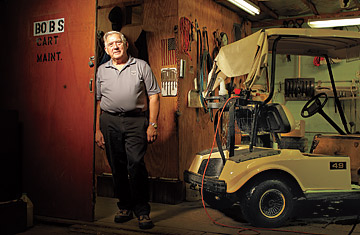
Robert Shively, 68, worked in a chemical plant for 36 years, but that didn't earn him an easy retirement.
(6 of 8)
Trying to boost returns by adding stocks can make matters worse. Even if you withdraw a mere 4% a year from your 401(k) and have an ultraconservative portfolio of 80% bonds and 20% stocks, you still have a chance of outliving your retirement account. Swap the bonds for stocks, and the chance of outliving your money actually rises. In reality, most of us don't have nearly enough in our 401(k) to live off just 4%. At a 6% withdrawal rate, hypothetical retirees in more than a third of the Monte Carlo simulations crapped out.
Saving more, another common prescription for fixing the 401(k), has its downside too. That's because of another unpleasant quirk of the 401(k), which was mentioned earlier: the older you are, the riskier a 401(k) gets. That's because contributions make up a very big part of the account's growth in the early years. Later on, once the account has grown, it is much more sensitive to market drops.
Imagine a worker who earns $100,000 a year for 30 years. Each year she puts 5% of her income into her 401(k). Through most of her working life, the market does pretty well, boosting her diversified portfolio 5% a year on average. When she retires, our worker will have $332,194 in her account. Now imagine a second, thriftier worker contributing 7.5% of his salary, or $2,500 more a year, to his 401(k). But in this scenario, the market does a 2008 in the last year before he retires, and his account drops 30%. Result? Even after saving 50% more a year for 30 years, worker No. 2 ends up with a balance of $327,194--$5,000 less than the first worker.
The 401(k) Alternative
So what can be done to fix our retirement-savings mess? Most of the proposed fixes to our retirement plans have to do with getting people to save more or invest better. The most popular solution is the so-called automatic 401(k). Under that plan, all workers would be enrolled in 401(k)s when they're eligible. Companies would establish default settings to boost returns and make the portfolios safer as workers near retirement. People who worked for companies that didn't offer 401(k)s would be automatically enrolled in savings accounts. In other words, make inertia work for employees, not against them. However, a number of economists and policy experts think that while those changes would help, upgrading the 401(k) alone won't save the nation's retirement-savings problem.
Here's why: Remember, the biggest factor in whether the 401(k) works as designed has to do with when you retire. If the market rises that year, you're fine. If you retired last year, you're toast. And the chances of your becoming a victim of this huge flaw in the 401(k) plan are pretty high. The market fell in four of the nine years since the beginning of the decade. That means anyone retiring this decade had a nearly 50% chance of leaving work in a down market. In fact, your chances of retiring into a down market are even greater than that: forced retirements spike in recessions just as the stock market is tanking.
